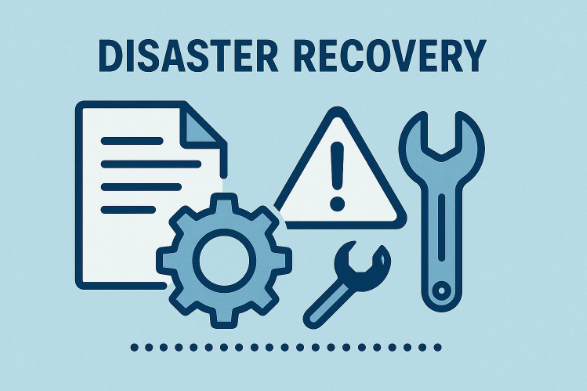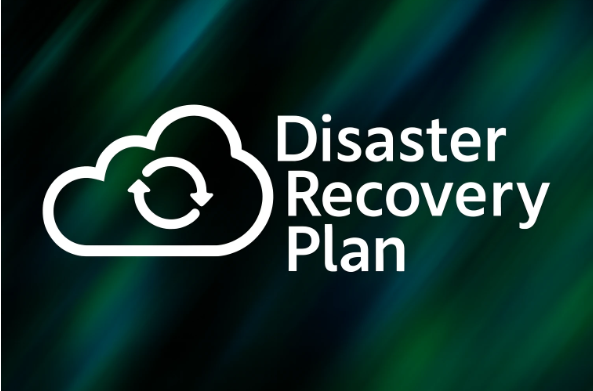Servers, cloud services, CRMs, and databases — all these systems ensure the daily operation of a business. But even the most reliable technologies don’t guarantee absolute protection from failures. Power can go out, an internet provider can experience an outage, and human error can lead to the loss of critical data.
At such moments, the difference between companies that recover quickly and those that stop working for days is defined by one factor — the presence of a Disaster Recovery Plan (DRP). It’s not just a set of instructions but a strategic document that outlines how the business continues to operate after an incident.
For company owners and startup founders, a disaster recovery services and DR plan is not a technical tools but insurance against downtime, financial losses, and reputational risks. While traditional insurance compensates monetary damage, a recovery plan protects what money can’t buy — customer trust and business stability.
DR is not about “if a failure happens” — it’s about “when it happens.” Every infrastructure eventually faces incidents. The only question is how ready you are when that moment comes.
What a Disaster Recovery Plan Is
A Disaster Recovery Plan (DRP) is a pre-defined set of actions that allows a company to quickly restore its IT systems after outages, cyberattacks, hardware failures, or natural disasters. Its main goal is simple — to minimize downtime and prevent data loss.
1. Key Components of a DR Plan
A well-designed DRP typically includes several critical elements:
- Data Backups — regular creation of copies of critical systems and databases stored at independent sites.
- Failover Sites — alternative data centers or cloud environments where workloads can be quickly transferred
- Defined Recovery Metrics:
– RTO (Recovery Time Objective) — how long it takes to restore a system;
– RPO (Recovery Point Objective) — how much data can be lost without causing serious damage. - Notification and Response Procedures — who responds, when, and how in the event of an incident.
These elements are effective only when documented, tested, and regularly updated as the infrastructure evolves.
2. The Difference Between DR and Regular Backups
Many companies mistakenly believe that having backups equals being disaster-ready. But backups are only one part of the strategy. A backup answers the question “where is the data stored?”, while DR answers “how quickly can the business continue operating?” Even if backups exist, the absence of a fast recovery mechanism can make downtime more costly than the infrastructure itself.
3. Why Testing Matters
A plan that exists only on paper is useless. Without regular testing, the team doesn’t know how to act during a real incident. Professional companies run recovery drills at least once per quarter — testing response speed, system transfer time, and team coordination.
Typical Causes of Failures and Data Loss
Most incidents that cause data loss or business downtime don’t happen because of literal “disasters.” In most cases, they result from human error, failed updates, hardware malfunctions, or the instability of external providers. Understanding these causes helps assess risks realistically and build a recovery plan based on real-world scenarios.
1. Technical Failures
The most common cause is hardware malfunction. Even modern servers and storage systems (SAN/NAS) can fail — power supplies burn out, disks crash, or controller errors occur. Even with reliable infrastructure, power outages, overheating, or defective components can cause data loss or temporary unavailability of services. The second major category is software failures. Bugs in updates, module incompatibility, or incorrect configurations can bring a system down faster than a virus or hacker attack.
2. Human Error
Statistics show that up to 40% of IT incidents are caused by human mistakes. An administrator might delete a database, forget to run a backup, or misconfigure network equipment. Even experienced engineers are not immune to errors — especially under time pressure. That’s why an effective Disaster Recovery Plan must consider not only technologies but also procedures: who has access, who approves changes, and who is responsible for system recovery.
3. External Factors and Infrastructure Risks
Sometimes, the issue arises outside the company: a provider outage, a power grid failure, a fire, a flood, or even downtime in a global cloud platform. There have been real cases in major European and U.S. data centers where thousands of clients lost access to their data due to power or cooling issues.
4. Cyberthreats and Ransomware
Modern attacks are increasingly aimed not at stealing data but at blocking access to it.
Ransomware encrypts files and demands payment for decryption. Without a well-prepared DR plan and isolated backups, a business can find itself completely paralyzed — unable to restore systems or continue operations.
Why Disaster Recovery Is Not an Expense but an Investment in Resilience
In many companies, creating a disaster recovery plan is seen as an “insurance policy that might never be used.” But that mindset is exactly what makes a business vulnerable. The truth is simple — the cost of downtime is always higher than the cost of preparation.
1. The Cost of Downtime: Numbers You Can’t Ignore
According to IDC, downtime of corporate infrastructure costs mid-sized businesses from $100,000 to $500,000 per hour, depending on the industry. Even for small companies, the losses reach tens of thousands of euros per hour — especially for e-commerce, SaaS platforms, or financial services. And if the outage affects not only internal systems but also customers — such as an unavailable website or CRM — the damage becomes both financial and reputational.
2. DR Covers Risks That Insurance Never Will
Insurance policies can compensate for physical losses — equipment, buildings, and property.
But no insurance company can restore lost data or recover customer trust. Disaster Recovery is a different kind of protection — it safeguards the continuity of operations, something that cannot be bought or replaced.
3. The Financial Logic of Investment
Developing a DR plan requires investment — audits, backup sites, automation, and testing.
However, in the long term, it’s an investment in business continuity. Companies with a well-structured recovery system reduce their Mean Time to Recovery (MTTR) by 3–5 times and minimize the probability of catastrophic incidents to near zero.
4. Reputation and Customer Trust
Today’s customers expect digital services to run without interruption. When a website, app, or CRM goes down, users don’t care about the reason — they simply leave for a competitor. Having a DR plan is not just a matter of internal security — it’s a customer retention tool.
In the digital economy, resilience has become the new synonym for trust.
How to Build an Effective Disaster Recovery Plan

A real Disaster Recovery Plan (DRP) is not a template or a one-time document. It’s a living system that evolves together with the business and its infrastructure. For the plan to actually work, it must be built step by step — from risk analysis to regular testing.
1. Risk Audit and Identification of Critical Systems
The first step is to determine which services and data are mission-critical for the business. Which systems must be restored first? What happens if they’re unavailable for an hour, a day, or a week? At this stage, a dependency map is created — including CRM, billing, ERP, websites, databases, and APIs — everything the business cannot function without.
For each system, two key metrics are defined:
- RTO (Recovery Time Objective) — how quickly operations must be restored;
- RPO (Recovery Point Objective) — how much data can be lost without serious impact.
2. Choosing a Recovery Strategy
There are several common approaches:
- On-premise DR — a backup site hosted on the company’s own infrastructure;
- Cloud DR — using cloud platforms to recover operations after an outage;
- Hybrid DR — a combined model where some systems are backed up in the cloud and others locally.
The choice depends on budget, infrastructure scale, and security requirements. The key rule: the backup site must be physically and logically independent from the primary data center.
3. Backup and Automation
Backups should be created regularly, automatically, and stored offsite.
The 3-2-1 rule is considered best practice:
- 3 copies of data,
- 2 different storage types,
- 1 copy stored off the main site.
Modern backup systems can restore not only files, but also entire virtual machines, applications, and databases, ensuring minimal downtime.
4. Testing and Simulations
Without testing, even the best-written plan loses its value. Companies that conduct regular recovery drills reduce their real incident response time severalfold. Testing helps identify weaknesses — errors in recovery scripts, poor team coordination, or insufficient network throughput at backup sites.
5. Continuous Updates and Control
Business infrastructure is constantly evolving — new services are added, technologies are updated, teams change. If the DR plan isn’t reviewed at least every six months, it becomes outdated. Leading companies implement a continuous DR audit process: they assign responsible teams, update contact information, and conduct regular internal training sessions.
What Makes a Real Disaster Recovery Plan Different from a Formal One
Many companies have a Disaster Recovery (DR) plan — at least on paper. It may be mentioned in a security policy, attached to a data center agreement, or stored somewhere in corporate documentation. The problem? When a real outage happens, it turns out that no one has ever read, updated, or tested it. A genuine DR plan stands out for one simple reason — it actually works in real life.
1. A Document vs. a Working Process
A formal plan is a PDF file created “to meet compliance requirements.” A real plan is a tested process — with assigned roles, contact lists, timelines, and clear procedures. If, during an outage, employees open the DR instructions for the first time — it’s not a plan, it’s an illusion of security.
2. Regular Drills and Testing
Companies that take DR seriously run recovery simulations — they imitate system failures, measure reaction speed, and test failover sites. Results are logged, analyzed, and used to improve procedures. Only practice reveals weak spots — forgotten passwords, outdated IP addresses, or dependencies on a single team member.
3. Defined Roles and Responsibility
A real DR plan always includes a clear responsibility matrix — who decides to initiate recovery, who manages infrastructure, and who communicates with clients. Without this structure, incident response becomes chaotic and full of duplicated efforts.
4. Data Accuracy and Relevance
Plans that are not updated become obsolete faster than expected. New systems, network changes, or migration to another data center can make an old version useless. Mature companies integrate DR updates into their Change Management cycle — ensuring the plan always reflects the current state of infrastructure.
5. A Culture of Accountability
The key difference of a mature DR strategy lies in leadership attitude. Where Disaster Recovery is treated as part of business resilience — not just an IT function — the plan truly works. When management sees DR as a tool for retaining customers and revenue, priorities shift: metrics are tracked, staff is trained, and automation becomes a justified investment.
Disaster Recovery — The Foundation of Controlled Growth

True business resilience starts not with technology but with the ability to act when technology fails. Disaster Recovery is not just an IT tool — it’s a strategic framework for survival in a world where failures are inevitable.
A Disaster Recovery Plan is real business insurance — but instead of a paper policy, it relies on people, processes, and infrastructure. It protects not physical assets but continuity, reputation, and customer trust — the things that money can’t replace.
For startups and established companies alike, the question is not if a failure will occur, but how quickly you can recover. Organizations with a tested DR plan return to normal operations within hours. Those without one lose days, clients, and investor confidence.
A Disaster Recovery Plan is not a checklist — it’s a system of responsibility. It demands discipline, investment, and regular practice. But it turns crisis into a controlled process — not a catastrophe. Because the true insurance of a business is not a certificate on the wall, but the ability to survive any disruption and keep moving forward.


